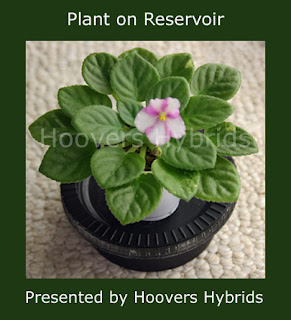Beauty is in the eye of the beholder! While these varieties may not top everyone's list of favorites, they certainly top mine!
In an effort to avoid writing a novel with this blog entry, I've limited my favorites to three per type.
Miniatures
Damas (A. E. Adams) - Somehow the violet community seems to have either overlooked Mr. Adams' work or simply didn't find the time to fully appreciate what he had given us. Two of my favorite miniatures come from this understated Canadian hybridizer. The black green serrated girl foliage is adorned with single dark rose blossoms that sport a thin feathered white edge.
Precious Red (Pittman) - Quite possibly the plant which will define Hortense's legacy. It's perfect in every way. The semidouble to double red blossoms are produced in mass atop the black-green, pointed foliage. If this plant has a flaw I haven't found it yet!
Tamsen (A. E. Adams) - Understated beauty might best describe this little gem. Single dark rose two-tone/thin green edge blossoms are beautiful atop the dark green girl foliage.
Semiminiatures
Dean's Cupid (Hobbs) - If you aren't growing this great variety you're certainly missing out. It's not one of these "wannbe" semiminiatures that looks like a miniature in disguise. The deep velvety purple blossoms contrast so beautifully with the deep green and white variegated foliage.
Tiptop (Pittman) - This little semiminiature does everything well...including standing the test of time. Introduced in June 1987, yes 23 years ago, it blooms profusely - and I do mean profusely and the foliage is a rich dark green which is a great contrast with the fuchsia/pink pansy blossoms. It shapes into a perfect rosette with little effort on the part of the grower.
Wee Be (Pittman) - A perpetual favorite of mine that has been around for over 22 years! Don't deny yourself the joy of growing this variety. I do have it on auction a few times a year so keep your eyes peeled!
Trailers
Happy Trails (L. Lyon) - Ruth Coulson from Australia grew the most spectacular specimen of this variety which was pictured in the African Violet Magazine (AVM) back in the mid 1990's. When that issue of the AVM hit member homes it caused a run on this plant so deep that it was impossible to get so much as a leaf for quite some time.
Spunky Trail (S. Sorano) - Is it a coincidence that my three favorite trailers come from Lyndon Lyon Greenhouses? This little trailer is just fun to grow. It stays quite small rarely growing larger than a baseball. It's little pink bell blossoms are freely produced over very dark green, shiny foliage.
Pip Squeek (L. Lyon) - This little gem probably won't win a best trailer award at your local show but it is just the greatest little plant to grow. This one too stays quite small and has dainty little pink star blossoms. Thirty two years after being released by Lyndon Lyon it is still going strong!
What favorites do you have and why?






























